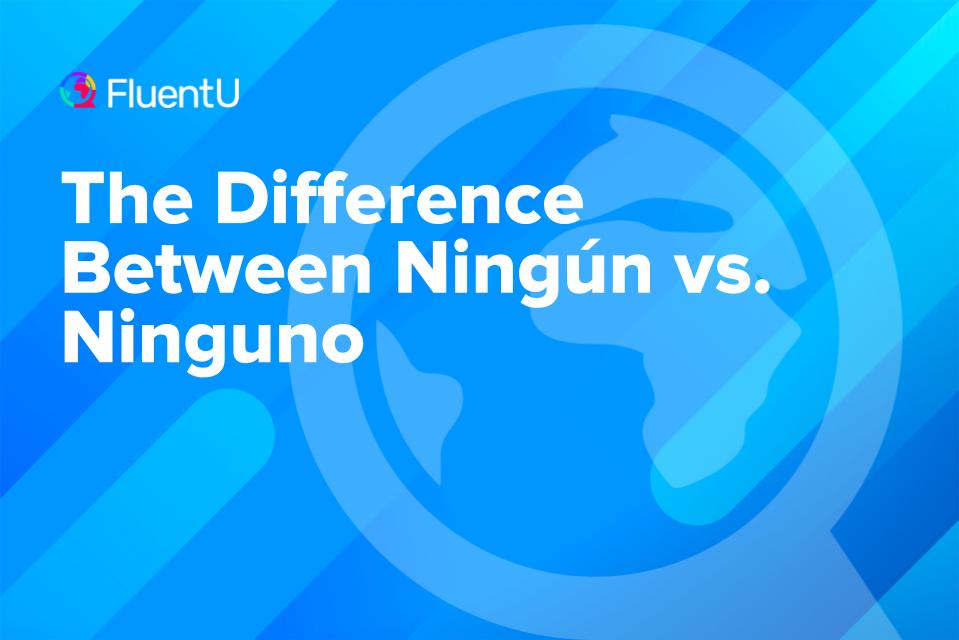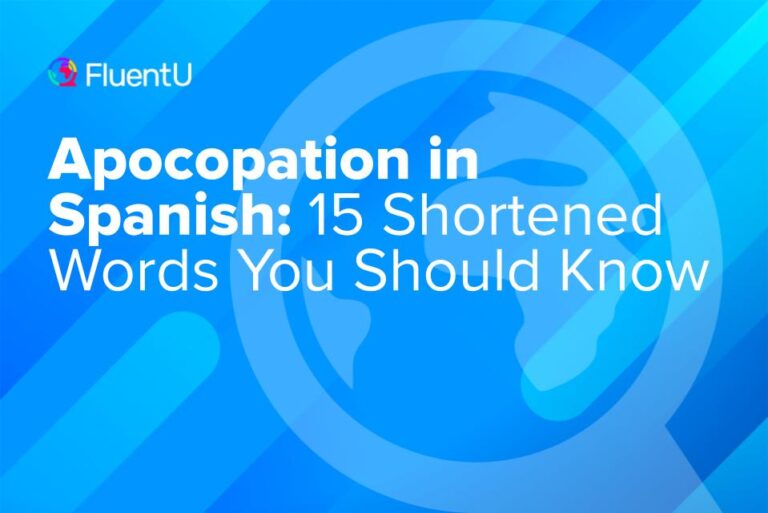The Difference Between Ningún vs. Ninguno

In order to refer to unspecified people, objects, or amounts in Spanish, you’ll need to understand indefinite adjectives and pronouns. These words, such as algún and ningún, help add nuance to your sentences but require specific rules for usage (including agreement with gender and number).
I’m going to break down the differences between indefinite adjectives and pronouns, their positive and negative forms and when to use each.
Download: This blog post is available as a convenient and portable PDF that you can take anywhere. Click here to get a copy. (Download)
An Introduction to Ningún vs. Ninguno and Other Indefinite Relatives
Before we dive into specifics, it will be helpful to understand the parts of speech that ningún and ninguno belong to.
To do that, you need to learn about indefinite adjectives and indefinite pronouns.
The simplest explanation is that one word (ningún) is an adjective, while the other (ninguno) is a pronoun. But let’s delve deeper into that.
Grammatically speaking, here are the differences between indefinite adjectives and indefinite pronouns:
- An indefinite adjective is an adjective that refers to an unspecified noun. If you say you want “any shirt,” the indefinite adjective “any” refers to “shirt” but the very meaning of the word “any” makes that shirt unspecific, because it can be any shirt in the world.
- An indefinite pronoun is a pronoun that substitutes any unspecified noun. Again, if you want “any shirt,” but I tell you “I don’t have any,” this last “any” substitutes “any shirt,” which, as we know, is an unspecified shirt. Therefore, “any” is a pronoun in the second sentence.
In other words, adjectives accompany the noun they refer to, while pronouns substitute that noun.
Let’s take the word alguna (some/any, feminine) as an example:
¿Tienes alguna pregunta? (Do you have any questions?)
Here, alguna is modifying the noun pregunta, so it’s an adjective.
On the other hand, if we answer that question like this:
No, no tengo ninguna. (No, I don’t have any (questions).)
Since, in this case, ninguna is used to refer to and substitute for pregunta, it’s therefore a pronoun.
There are a few things you have to remember about indefinite adjectives and pronouns before you proceed:
- Indefinite pronouns and adjectives can be positive or negative. The ones starting with an n- are negative, while the rest are positive.
- Indefinite adjectives always need to be followed by a noun, regardless of whether they’re positive or negative. Otherwise, they become pronouns.
- Indefinite adjectives and pronouns must always agree in gender and number with the noun they refer to.
- Of course, negative indefinites add a negative aspect to the sentence. Remember that Spanish allows you to use double negatives, so don’t be surprised to find a sentence where you have no … + … indefinite ( No quiero a nadie — I don’t love anyone).
- However, if you start a sentence with an indefinite, you can no longer use no ( Nadie me quiere — Nobody loves me).
The easiest way to learn the difference between ningún and ninguno and the meanings of the Spanish indefinite adjectives and pronouns is by studying them separately.
The following is a list of the main Spanish indefinite adjectives and pronouns. For each of them, you’ll find an English translation and examples of how they’re used.
The Algún and Ningún Families
Algún can be translated as “any,” some” or “a few,” depending on the context.
Ningún means “no” or “not any,” also depending on the context.
But algún and ningún cannot live by themselves! They both have “siblings,” so to speak, and each sibling has its own role.
As I mentioned before, indefinite adjectives and pronouns must agree in gender and number with the noun they refer to. This is the reason Spanish has four positive indefinite adjectives and four negative indefinite adjectives (as you can see in the table below).
All of these eight indefinites are adjectives, which means they must be followed by a noun. Never forget that!
Here are some examples:
| Gender and Number | Algún | Ningún | Example Sentence | English Translation |
|---|---|---|---|---|
| Masculine Singular | algún | ningún | ¿Tienes algún amigo español? | Do you have any Spanish friends? |
| Masculine Plural | algunos | ningunos | Hemos comprado algunos libros. | We've bought some books. |
| Feminine Singular | alguna | ninguna | No quiero ninguna camiseta. | I don't want any T-shirts. |
| Feminine Plural | algunas | ningunas | He olvidado algunas cosas. | I've forgotten a few things. |
The adjectives ningunos and ningunas do exist and are still sometimes used, but native speakers generally prefer using only their singular counterparts.
For example, if you want to say you don’t have any siblings—siblings being a plural noun—you would want to opt for the singular form of the indefinite and the noun in Spanish, like so:
No tengo ningún hermano. (I don’t have any siblings.) rather than No tengo ningunos hermanos.
The plural option sounds weird nowadays. Try to avoid using it whenever you can.
Algún vs. Alguno
I always tell my students that alguno is the older, independent brother that lives by himself in his apartment and only comes to visit from time to time. Why?
Well, the difference between algún and alguno will help you understand why.
As you know, algún is an adjective and must be followed (or taken care of) by a noun:
¿Has leído algún libro de García Márquez? (Have you read any García Márquez books?)
Alguno, on the other hand, is a pronoun, so it does its job by itself:
Sí, he leído alguno. (Yes, I have read one.)
Note that, in the second one, we do not specify which book, as it can be any of García Márquez’s books.
Ningún vs. Ninguno
As I briefly mentioned earlier, the difference between ningún and ninguno is that ningún is an adjective while ninguno is a pronoun.
The same rules for algún and alguno apply here: ningún needs to be followed by a noun, while ninguno does its job by itself and doesn’t accept any:
No tengo ningún amigo español. (I don’t have any Spanish friends.)
No tengo ninguno. (I don’t have any.)
Notice that all four words (algún, alguno, ningún and ninguno) are masculine and singular. This isn’t just me being a misogynist. The fact is that only masculine singular indefinite adjectives and pronouns have this duality, so you’ll only have a little headache with these four.
Luckily, the rest of the members of both families don’t change when they “transform” into pronouns:
¿Tienes alguna amiga de México? (Do you have any Mexican girl friends?)
¿Tienes alguna? (Do you have any?)
No vino ninguna niña. (No girl came.)
No vino ninguna. (None came.)
Quick Recap of Indefinite Relatives in Spanish
Let’s do a quick summary of what we’ve just learned before we move on to other members of this word family:
| Spanish Indefinites | Means "Any" | Means "Not Any" | Male | Female | Adjective | Pronoun |
|---|---|---|---|---|---|---|
| Algún | Yes | No | Yes | No | Yes | No |
| Alguno | Yes | No | Yes | No | No | Yes |
| Ningún | No | Yes | Yes | No | Yes | No |
| Ninguno | No | Yes | Yes | No | No | Yes |
| Alguna | Yes | No | No | Yes | Yes | Yes |
| Ninguna | No | Yes | No | Yes | Yes | Yes |
Now, you’re ready to learn a few more often-confusing word pairs!
Alguien vs. Nadie
Alguien and nadie are only used to refer to people.
Alguien means “someone, anyone, somebody, anybody,” while nadie means “no one, nobody.”
As with every indefinite adjective and pronoun, the one starting with n- is the negative counterpart of the duo.
These two words are exclusively pronouns, meaning they will always appear by themselves. They will always refer to a person but will never have a noun with them:
¿Hay alguien ahí? (Is anyone there?)
Aquí no hay nadie. (There’s no one here.)
Remember that when a negative indefinite starts the sentence, you aren’t allowed to use no any longer. For example, you say Nadie me quiere. (Nobody loves me) instead of Nadie no me quiere.
Algo vs. Nada
Our last couple of indefinites are algo and nada .
They’re similar to alguien and nadie in that they can only be pronouns and one (nada) is the negative equivalent of the other one (algo).
However, just as alguien and nadie can only refer to unspecific people, algo and nada can only refer to unspecific objects.
Algo means “something,” and it can be used to refer to literally everything:
Necesito algo de beber. (I need something to drink.)
The above statement implies that you don’t mind if what you drink is water, wine, juice, coffee or any other beverage.
On the other hand, nada means “nothing, anything,” so it excludes everything:
No necesito nada. (I need nothing./I don’t need anything.)
Nada te parece bien. (Nothing seems OK to you.)
Tips to Practice Ningún, Ninguno and Other Indefinite Relatives
This is one of those topics that work quite similarly in English and Spanish.
To recap:
- Spanish makes adjectives and pronouns agree with the noun they refer to.
- Indefinite adjectives and pronouns can refer to everything and everybody.
- Masculine singular adjectives add an extra -o when they transform into pronouns.
- A negative indefinite at the beginning of a sentence doesn’t allow no to appear in said sentence.
These concepts will come more naturally the more you practice. But for a little extra learning support, the FluentU language learning program can help you learn in context through Spanish videos.
FluentU takes authentic videos—like music videos, movie trailers, news and inspiring talks—and turns them into personalized language learning lessons.
You can try FluentU for free for 2 weeks. Check out the website or download the iOS app or Android app.
P.S. Click here to take advantage of our current sale! (Expires at the end of this month)

And that’s everything you need to know about Spanish indefinite adjectives and pronouns!
Remember to stay curious and, as always, happy learning!
Download: This blog post is available as a convenient and portable PDF that you can take anywhere. Click here to get a copy. (Download)
And One More Thing…
If you've made it this far that means you probably enjoy learning Spanish with engaging material and will then love FluentU.
Other sites use scripted content. FluentU uses a natural approach that helps you ease into the Spanish language and culture over time. You’ll learn Spanish as it’s actually spoken by real people.
FluentU has a wide variety of videos, as you can see here:

FluentU brings native videos within reach with interactive transcripts. You can tap on any word to look it up instantly. Every definition has examples that have been written to help you understand how the word is used. If you see an interesting word you don’t know, you can add it to a vocab list.

Review a complete interactive transcript under the Dialogue tab, and find words and phrases listed under Vocab.

Learn all the vocabulary in any video with FluentU’s robust learning engine. Swipe left or right to see more examples of the word you’re on.

The best part is that FluentU keeps track of the vocabulary that you’re learning, and gives you extra practice with difficult words. It'll even remind you when it’s time to review what you’ve learned. Every learner has a truly personalized experience, even if they’re learning with the same video.
Start using the FluentU website on your computer or tablet or, better yet, download the FluentU app from the iTunes or Google Play store. Click here to take advantage of our current sale! (Expires at the end of this month.)







